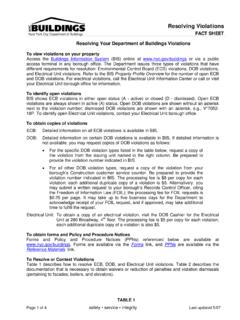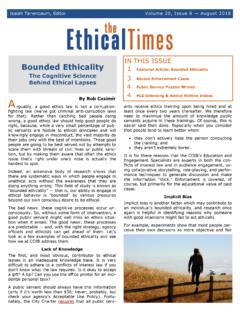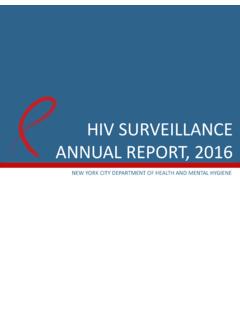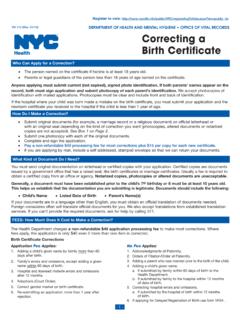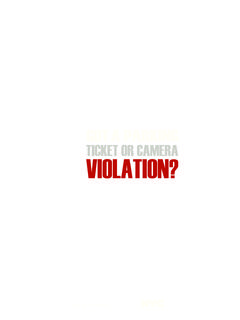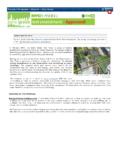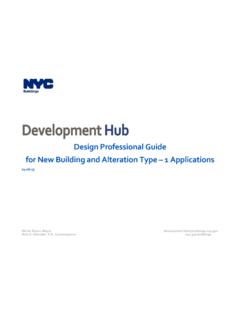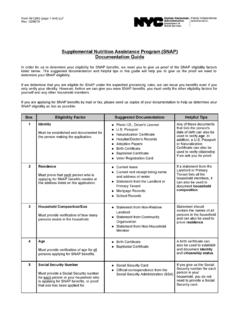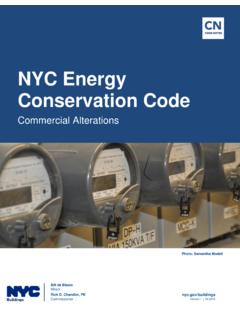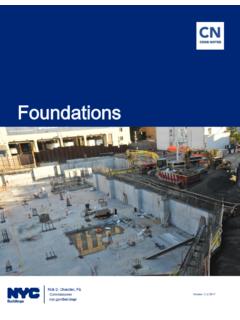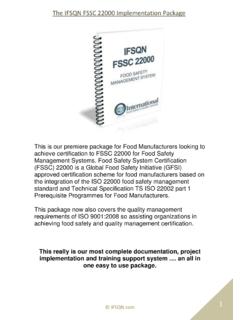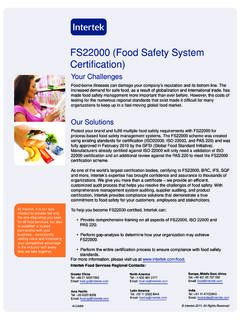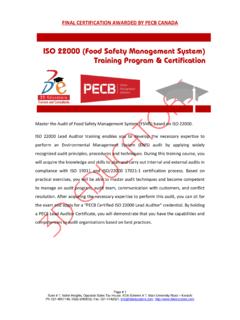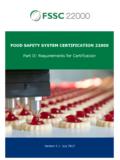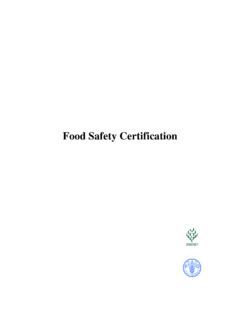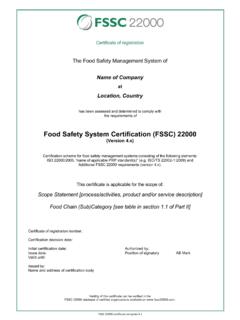Transcription of PROTECTION TRAINING MANUAL - Welcome to NYC.gov
1 The Health CodeThese are regulations that wereformulated to allow the Departmentto effectively protect the health of thepopulation. Among the rulesembodied in the Health Code isArticle 81 which regulates the oper-ations of food establishments forthe purpose of preventing publichealth Health Division The Division of EnvironmentalHealth is the Commission within theHealth Department that is concernedwith public health and works toeliminate the incidence of injury andillness caused by environmental are several Offices andBureaus within this division. Oneof these is the Bureau of FoodSafety and Community Sanitationthat has the responsibility for con-ducting inspections of food serviceand food processing inspections are performed byPublic Health WarningAll Sanitarians have Departmentof Health and Mental Hygienebadges and identification cardswhich they must display wheneverit is requested of is illegal to offer a Sanitarianany bribe, gratuity or reward forofficial misconduct; this is a crimethat can result in fines, and /orimprisonment, and the revocationof permits.
2 Also, Sanitarians are notauthorized to conduct any monetarytransactions on behalf of GeneralThis is an office that exists withinthe Health Department with theresponsibility of investigating anyincidence of alleged corrupt may be conducted asa result of complaints by employeesof the Department or members ofthe AcademyThe Health Academy is an officewithin the Division of EnvironmentalHealth. One of its responsibilities isto provide TRAINING and certificationcourses for individuals from the publicas mandated by the Health food PROTECTION Course is oneof the courses taught here. The FoodProtection Course is required by theHealth Code for supervisors of foodservice establishments and non-retailfood processing establishments.
3 Theseindividuals must take the course andpass an examination before a certifi-cate is issued to them. A personholding such a certificate must be onthe premises and supervise all foodpreparation activities during all hoursof operation. Several supervisors withthis certification may be needed at anestablishment to have coverage dur-ing all shifts, vacations or food PROTECTION Manualhasbeen designed to assist participantsof the course to better understandthe principles of safe food serves as a reference for food ser-vice operators and it includes thenecessary information to pass thefinal food PROTECTION CourseThe food PROTECTION CourseinEnglish, Spanish and Chinese isnow also available on-line. Thiscourse is designed for individuals withbusy schedules to study at their con-venience.
4 After the completion ofthe course, a final examination isscheduled at the Health is done on-line. Thelink is: for Health AcademyClasses On-LineYou may now register and payonline for courses offered at theDepartment of Health and MentalHygiene s Health Academy, includ-ing the food PROTECTION Course forrestaurants. This new service allowsyou to avoid going to the CitywideLicensing Center to register for acourse. You may also use the on-lineservice to pay for and request anappointment to replace your FoodProtection does it work?Go to the registration web page, ,select acourse and date, pay the appropriatefee and receive confirmation. You will be asked to provide somepersonal information before regis-tering. In most cases, you will beable to select from a list of coursedates.
5 If you don t see a date that isconvenient, check back as newcourse dates are added dPROTECTION TRAINING MANUALNEW YORK CITY DEPARTMENT OF HEALTH & MENTAL HYGIENEINTRODUCTIONThe New York City Department of Health and MentalHygiene has the jurisdiction to regulate all mattersaffecting health in the city and to perform all thosefunctions and operations that relate to the health of the peopleof the United States has one of thesafest food safety systems in the world,yet millions of Americans still getsick each year from eating contami-nated foods; hundreds of thousandsare hospitalized; and several thou-sand die. This means that there isstill tremendous room for improve-ment in food safety food -borne illnesses arecaused by improper handling offood.
6 The statistics from the Centersfor Disease Control (CDC) showthat some of the most commoncauses of foodborne illness are: Sick food worker Poor personal Hygiene/Bare handcontact Improper holding temperatures Improper cooling Inadequate cooking and reheating Cross contamination Use of food from unknown sourceWhat is food -Borne Illness?Any illness that is caused by foodis called food -borne illness. A food -borne illness outbreak is defined asany incident involving two or morepersons becoming ill with similarsymptoms from the same these illnesses are a directresult of contamination of food byharmful microorganisms, (commonlycalled germs) such as bacteria,viruses, parasites, fungi etc. Injuryand illness caused by foreign objects,dangerous chemicals and/or allergensin food is also considered a food -borne is at Risk?
7 We are all at risk of getting a foodborne illness; however, the effects aremore severe for certain categories ofindividuals: Children whose immune system(human body s defense systemagainst diseases) is not fully devel-oped yet. Elderly individuals because theirimmune system is not robust any-more and has weakened due to oldage. Pregnant women where the threatis both to the mother and the fetus. Individuals with com-promised immune sys-tems , Patients withAIDS, cancer or indi-viduals who are diabet-ics, etc. People on medication(antibiotics, immunosup-pressant, etc.).What is food ? food is any edible sub-stance, ice, beverage, oringredient intended for useand used or sold forhuman are Potentially HazardousFoods (PHF)?This expression refers to those foodsthat provide suitable conditions forrapid growth of include foods that are high inprotein like raw or cooked animalproducts such as meats, poultry,fish, shellfish (mollusks as well ascrustaceans), milk and milk products(cheese, butter milk, heavy cream etc.)
8 ,),plant protein such as tofu, andstarches such as cooked rice, cookedpasta, cooked beans and cookedvegetables like potatoes, cut melons,cut leafy greens, cut tomatoes ormixtures of cut tomatoes, as well asraw seed sprouts and garlic in : Those foods that have alow water activity (.85 or less) or thosethat are highly acidic with a pH or below. Air-cooled hard-boiledeggs with shells dPROTECTION TRAINING MANUALNEW YORK CITY DEPARTMENT OF HEALTH & MENTAL HYGIENEINTRODUCTION TO food SAFETYQUICK REVIEW1. All food ser vice establishments must have a current and valid permit issued by the NYC Health Department. TRUE FALSE2. Health Inspectors have the right to inspect a food ser vice or food processing establishment as long as it is in must be given access to all areas of establishment during an inspection.
9 TRUE Inspectors are authorized to collect permit fees and fines on behalf of the Department. TRUE Inspectors must show their photo identification and badge to the person in charge of an establishment. TRUE to the NYC Health Code, who is required to have a food PROTECTION Certificate? Hazardous FoodsWhat is Ready-To- Eat food ?Any food product that does notneed additional heat treatment orwashing is called ready-to-eat food . Extra care must be taken to ensurethe safety of these foods. Where do we purchase foods?All foods must be purchased fromapproved sources. These are manu-facturers and suppliers who complywith all the rules and regulations thatpertain to the production of theirproduct, including having theHow do we store potentiallyhazardous foods?
10 All foods must be kept free fromadulteration, spoilage, filth orother contamination in order to besuitable for human hazardous foods are ofparticular concern because theyprovide the conditions suitable forthe growth of foods must be kept either hot orcold to prevent microorganisms fromgrowing. Hot means 140 F or aboveand cold means 41 F or below. Thetemperature range between 41 F and140 F is known as the temperaturedanger zone. It is within this rangethat microorganisms are comfortableand will grow rapidly. At 41 F andbelow, the temperature is coldenough to retard or slow down thegrowth of microorganisms, whileabove 140 F most of the microor-ganisms which cause foodborne ill-ness begin to only safe way to determinethat potentially hazardous foods arekept out of the temperature dangerzone is by the use of are several different types ofthermometers.
